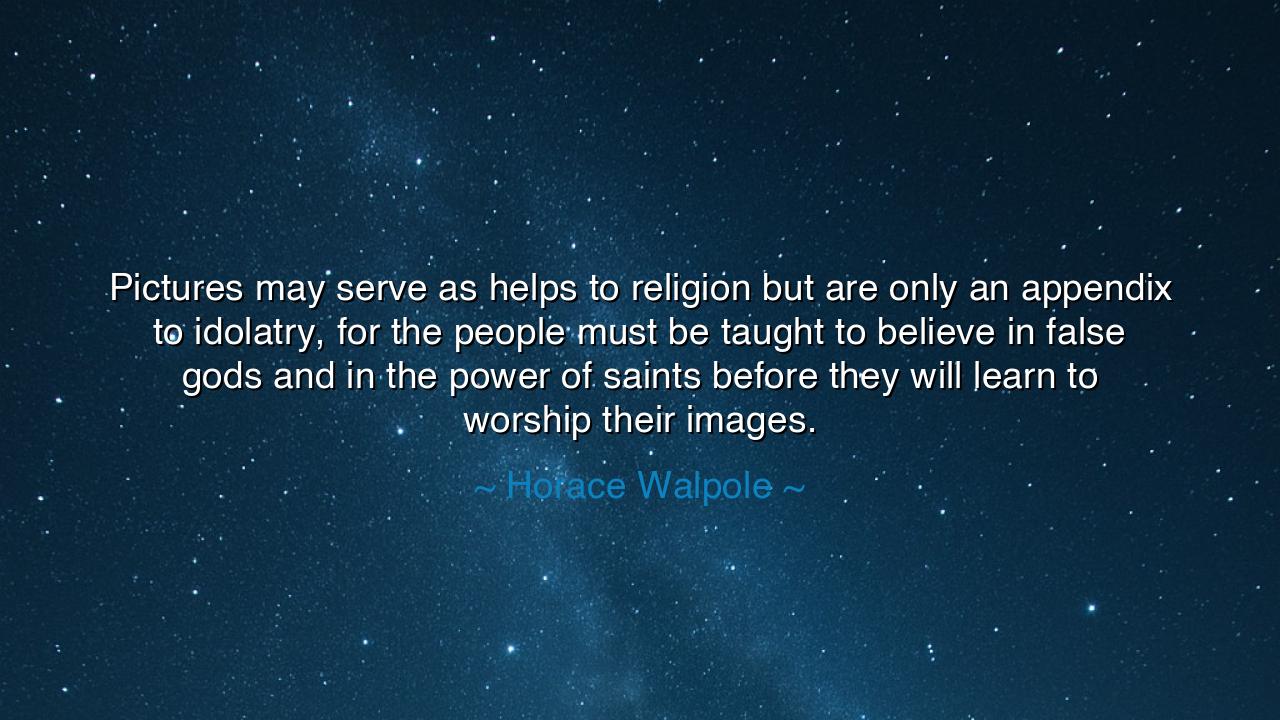
Pictures may serve as helps to religion but are only an appendix
Pictures may serve as helps to religion but are only an appendix to idolatry, for the people must be taught to believe in false gods and in the power of saints before they will learn to worship their images.






"Pictures may serve as helps to religion but are only an appendix to idolatry, for the people must be taught to believe in false gods and in the power of saints before they will learn to worship their images." These words, spoken by Horace Walpole, cut to the heart of an ancient and ongoing debate about the role of images and symbols in religion. Walpole’s critique speaks of a deep concern: the danger of transforming religious images into objects of worship rather than tools for contemplation. In his view, pictures in religion should aid spiritual reflection, but they should never replace the genuine worship of the divine. His statement is a call to discernment, urging us to reflect on whether our veneration of sacred images has become idolatrous, and whether we risk turning symbols into false gods that distract from the true nature of faith.
In the ancient world, the question of images in religion was not new. In Judaism, the very commandment against graven images (Exodus 20:4) was grounded in the belief that the divine could not and should not be confined to any material representation. The Hebrews, during their journey through the wilderness, were constantly warned against idolatry, the worship of images, because it detracted from the living and unseen God. This principle resonated deeply in ancient religious traditions, where the divine was considered transcendent and beyond the grasp of human imagination. To confine it to an object of wood or stone was to reduce it to something less than its true nature.
However, as Christianity spread throughout the Roman Empire, and particularly after the Constantinian shift, the use of religious images became more widespread. The Church began to embrace the use of icons, statues, and paintings as means of expressing faith and teaching the gospel. But as Walpole points out, these images began to take on a life of their own. Over time, certain saints and relics were venerated in ways that seemed to elevate them to divine status. People began to pray to images of saints, ascribing to them a power that was meant to be reserved for God alone. Worship, in this sense, could be directed toward the image itself, rather than the spiritual truths the image was intended to represent.
One of the most striking historical examples of this shift can be found in the Byzantine Empire, where the Iconoclast Controversy (8th–9th century) ignited a fierce debate over the role of icons in Christianity. The Emperor Leo III, and later his successors, argued that veneration of icons was a form of idolatry, and sought to ban them, leading to the destruction of countless religious images. On the other side, defenders of the icons, such as John of Damascus, argued that the icons were not objects of worship, but aids to faith, allowing the faithful to contemplate the divine. The conflict, which ultimately resulted in the affirmation of the use of images at the Second Council of Nicaea in 787, highlights the tension Walpole speaks to: the fine line between using images as aids to religion and allowing them to replace the true worship of the divine.
The heart of Walpole’s criticism lies in the danger of images becoming idols, distractions that obscure the deeper spiritual truths. The image, in his view, serves a purpose—to help elevate the mind toward the divine—but when it is worshipped in place of the divine, it becomes an appendix to idolatry. This is not merely a critique of Christianity but a broader warning about how human beings are prone to materializing the spiritual, turning symbols of the sacred into the sacred itself. Idolatry, as Walpole suggests, does not require the worship of statues alone; it can be the worship of any form that distracts us from the living God—whether it be a person, a thing, or an idea.
This lesson carries over into our own lives today. We must ask ourselves: What do we worship? What symbols, images, or ideas have we allowed to take the place of true spirituality? Are we, perhaps, guilty of turning something that was meant to help our faith into the object of our faith? In the modern world, the images of consumerism, politics, and celebrity often replace true spiritual reflection. We may not bow to statues, but we may place our trust and devotion in false gods: wealth, power, status, or even self-image. These idols do not lead us to the divine but away from it, filling our lives with empty promises and distractions.
The lesson, then, is one of clarity and focus. Let us recognize the value of images in their proper place—as tools to elevate our minds and hearts toward the divine, but not as objects to be worshipped. Religion, at its heart, is about relationship with the divine, not about objects or rituals. We must keep our eyes focused on the living God, not on the symbols that are meant to point us toward Him. Let us not fall into the trap of idolatry, where we worship the forms of faith instead of the substance of faith. In doing so, we can live with a deeper, more authentic spirituality that aligns us with the true purpose of our existence: to know and love the divine, not through images, but through the heart and soul.






AAdministratorAdministrator
Welcome, honored guests. Please leave a comment, we will respond soon